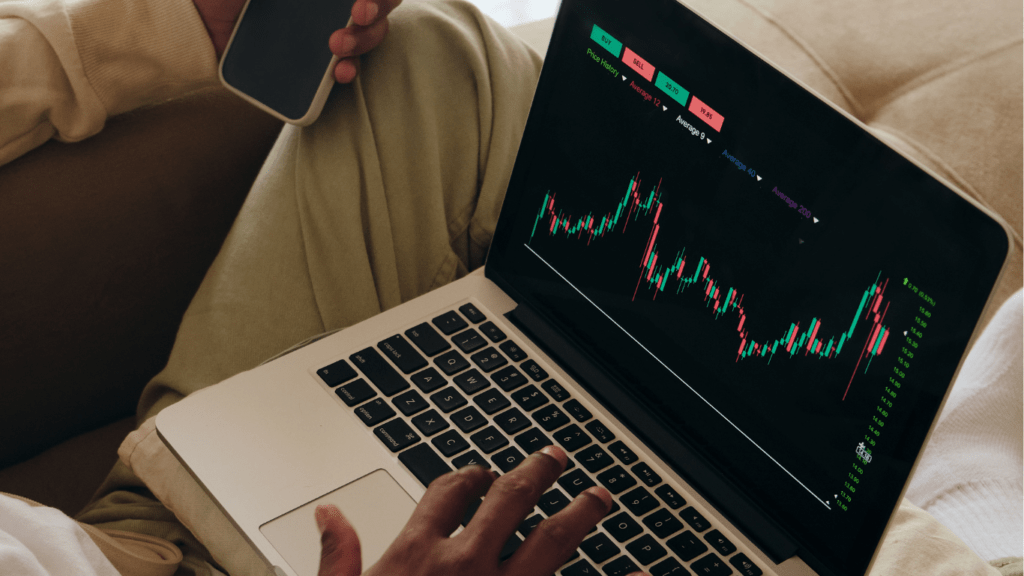Understanding Swing Trading
Swing trading involves holding positions for several days or weeks to capitalize on expected price movements. Unlike day trading, which focuses on intraday movements, swing trading seeks to profit from broader price swings within a medium-term timeframe. Traders identify potential entry and exit points based on technical analysis and market sentiment while managing risk and ensuring disciplined execution.
Key Concepts
- Market Trends: Identifying the overall direction of the market (uptrend, downtrend, sideways) is crucial. Traders use trendlines, moving averages, and indicators to confirm existing trends and anticipate reversals.
- Technical Analysis: Utilizing tools like MACD, RSI, and Fibonacci retracement levels helps traders forecast potential price movements. These technical indicators offer insights into market momentum and possible support/resistance levels.
- Volume Analysis: By analyzing trading volume, traders assess the strength of a trend. High volume during price increases suggests strong buying interest, while decreasing volume during price drops might indicate weakening selling pressure.
- Risk Management: Setting stop-loss and take-profit levels is essential to protect capital and secure profits. Effective risk management strategies include position sizing and adhering to predefined risk/reward ratios.
- Market Sentiment: Assessing the emotional and psychological factors driving market participants can provide insights beyond technical analysis. Factors such as news events, regulatory changes, and social media trends can impact market behavior.
Tools and Resources
- Charting Software: Platforms like TradingView and Coinigy offer advanced charting tools and technical indicators, essential for conducting thorough technical analysis.
- News Aggregators: Tools like CryptoPanic and CoinMarketCal help traders stay updated with relevant news that could affect market sentiment and price movements.
- Community Platforms: Joining crypto trading communities on Telegram, Reddit, or Discord can provide valuable insights, advice, and real-time updates from fellow traders.
- Identify Potential Trades: Use technical indicators to screen for assets showing potential entry points. Ensure the assets align with broader market trends and sentiment.
- Set Entry and Exit Points: Define clear entry and exit points based on technical analysis. Use support and resistance levels to determine these points.
- Monitor Trades: Continuously monitor open positions, adjust stop-loss orders as needed, and be prepared to act if market conditions change unexpectedly.
- Review and Adjust: Regularly review your trading strategy’s performance. Adapt strategies based on market conditions and past performance to optimize future trades.
Traders build successful swing trading strategies by understanding these core concepts, leveraging the right tools, and maintaining a disciplined approach.
The Basics of Swing Trading in Cryptocurrency
Swing trading in cryptocurrency involves methods to capitalize on market volatility over short-to-medium timeframes. Holding positions for days or weeks, traders aim to benefit from broader price movements.
Key Principles
Master Risk Management
Effective risk management ensures long-term success. Traders should set stop-loss levels based on support and resistance zones. For example, setting a stop-loss at 5% below the entry price limits potential losses.
Utilize Technical Analysis
Technical analysis tools assist in forecasting price movements. Indicators like Moving Average Convergence Divergence (MACD) and Relative Strength Index (RSI) help identify entry and exit points. Using these tools with chart patterns, such as head and shoulders, enhances accuracy.
Conduct Market Sentiment Analysis
Understanding market sentiment offers additional insight. Monitoring social media channels, news sources, and market-related forums helps gauge public opinion and potential market moves. For instance, a surge in positive news about Bitcoin can indicate an upcoming rally.
Common Strategies
Trend Following
Identifying and riding market trends generates profit. Traders look for confirmed trends using indicators like the Moving Averages and Bollinger Bands. Entering trades in the direction of the trend increases the probability of success.
Counter-Trend Trading
This strategy involves betting against the prevailing trend after identifying potential reversals. Traders use oscillators like Stochastic and RSI to detect overbought or oversold conditions. For example, if RSI indicates oversold conditions, entering a trade for a price rebound can be advantageous.
Breakout Trading
Breakout trading focuses on price levels that initiate new trends. By identifying key support and resistance levels, traders enter positions when the price breaks these levels. Engaging in trades post-breakout captures significant price movements quickly.
Tools and Indicators for Swing Trading

To excel in swing trading in the crypto market, the right tools and indicators are essential. Understanding both technical and fundamental aspects ensures informed decision-making.
Technical Analysis
Technical analysis includes studying past price movements to predict future trends. Three main tools are vital for this:
- Moving Averages: Using the Simple Moving Average (SMA) and Exponential Moving Average (EMA) to identify trends and reversals. For example, a cross of the 50-day SMA over the 200-day SMA indicates a bullish trend.
- MACD (Moving Average Convergence Divergence): This indicator helps spot changes in strength, direction, momentum, and duration of a trend. When the MACD line crosses above the signal line, it suggests a potential buy signal.
- RSI (Relative Strength Index): Commonly used to determine if an asset is overbought or oversold. An RSI value above 70 may indicate overbought conditions, while a value below 30 suggests oversold conditions.
- Project Whitepapers: Reviewing the project’s goals, technology, and use cases. For instance, Ethereum’s whitepaper outlines its plans for decentralized applications.
- Market News: Staying updated with news and events affecting the crypto market. Positive announcements, like institutional adoption, can drive prices higher.
- On-Chain Data: Analyzing data like transaction volumes, active addresses, and network hash rates. High transaction volumes often indicate strong interest in the asset
Risk Management in Swing Trading
Risk management is critical in swing trading, especially in the volatile crypto market. Making informed decisions helps protect investments and maximize returns.
Setting Stop-Loss Orders
Setting stop-loss orders is a primary tactic I use to limit potential losses in swing trading. Stop-loss orders automatically sell assets when prices reach a predetermined level, minimizing emotional decisions and managing risk more effectively. I set these levels based on asset volatility and personal risk tolerance.
Diversification
Diversification mitigates risk by spreading investments across different assets. In the crypto market, I invest in various cryptocurrencies like Bitcoin, Ethereum, and Solana. This reduces exposure to a single asset’s adverse price movements and stabilizes portfolio performance. Diversifying into different sectors within the crypto market can also balance risk and reward.
Benefits and Challenges
Swing trading provides opportunities and obstacles in the dynamic cryptocurrency market. Understanding these aspects is crucial for maximizing success.
Advantages of Swing Trading
Flexibility: Swing trading allows me to balance trading activities with other commitments. It’s less time-intensive than day trading, offering more freedom.
Profit Potential: With swing trading, I can capitalize on short-to-medium term price movements. These opportunities often yield significant returns.
Risk Management: Swing trading enables me to better manage risk by focusing on less frequent, more calculated trades. This reduces exposure to volatile daily price actions.
Learning Curve: Swing trading offers a manageable learning curve compared to other trading styles. I can gradually build my expertise without the steep demands of day trading.
Common Challenges
Market Volatility: The crypto market is highly volatile. Sudden price swings can lead to unexpected losses and require constant vigilance.
Emotional Stress: Swing trading demands emotional control. Rapid market changes can trigger stress and impulsive decisions, affecting trades negatively.
Time Commitment: Although less demanding than day trading, swing trading still requires significant time for research and analysis to make informed decisions.
Execution Speed: Speed and precision in executing trades can be challenging. Delays or errors can affect profitability, especially in a rapidly changing market.
These benefits and challenges highlight the nuanced art of swing trading in the crypto market. Understanding and navigating these elements enhances the likelihood of success.

 Ricky Morenolendez is a key contributor at The Digi Chain Exchange, recognized for his deep expertise in cryptocurrency and blockchain technology. With years of experience in analyzing market trends and providing actionable insights, Ricky has become a trusted voice in the crypto space. His work focuses on helping investors understand the nuances of digital assets, from Bitcoin to emerging altcoins. Ricky’s dedication to educating the community on market strategies and crypto developments has made him an invaluable asset to The Digi Chain Exchange team.
Ricky Morenolendez is a key contributor at The Digi Chain Exchange, recognized for his deep expertise in cryptocurrency and blockchain technology. With years of experience in analyzing market trends and providing actionable insights, Ricky has become a trusted voice in the crypto space. His work focuses on helping investors understand the nuances of digital assets, from Bitcoin to emerging altcoins. Ricky’s dedication to educating the community on market strategies and crypto developments has made him an invaluable asset to The Digi Chain Exchange team.

